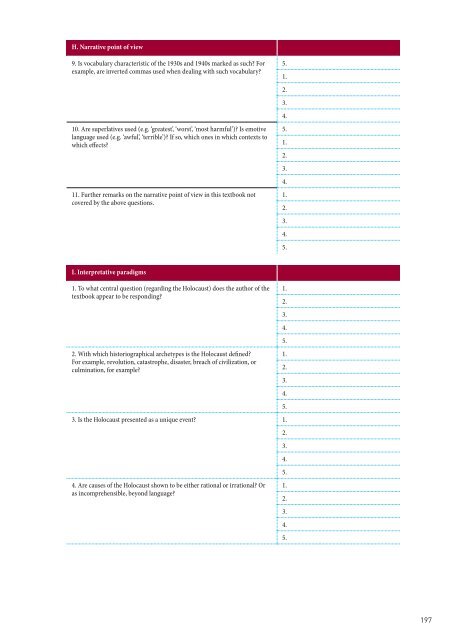- Page 1 and 2:
United Nations Educational, Scienti
- Page 3 and 4:
Published by the United Nations Edu
- Page 5 and 6:
Acknowledgements This report was co
- Page 7 and 8:
PART 3 Recommendations 171 6. Objec
- Page 9 and 10:
Concept The task of documenting the
- Page 11 and 12:
international learning about the Ho
- Page 13 and 14:
and narrative and didactic techniqu
- Page 15 and 16:
1. Background The release of this p
- Page 17 and 18:
This study does not provide a bluep
- Page 19 and 20:
Klerides claims, there are two genr
- Page 21 and 22:
of Education in Ecuador. 26 The num
- Page 23 and 24:
g. Countries customarily referred t
- Page 25 and 26:
3. Methodology This report is based
- Page 27 and 28:
the content of images, provide defi
- Page 29 and 30:
3. What characteristics are ascribe
- Page 31 and 32:
and its educational traditions. In
- Page 33 and 34:
4. The Holocaust in curricula world
- Page 35 and 36:
in contradistinction to the massacr
- Page 37 and 38:
the section concerning ethics, the
- Page 39 and 40:
4.2 Spatial distributions of the Ho
- Page 41 and 42:
Sweden Finland Russian Federation E
- Page 43 and 44:
The status of the Holocaust in curr
- Page 45 and 46:
The status of the Holocaust in curr
- Page 47 and 48:
4.3 Conceptualizations of the Holoc
- Page 49 and 50:
Country Name of document Subject Pa
- Page 51 and 52:
Country Name of document Subject Pa
- Page 53 and 54:
Country Name of document Subject Pa
- Page 55 and 56:
Country Name of document Subject Pa
- Page 57 and 58:
Country Name of document Subject Pa
- Page 59 and 60:
Country Name of document Subject Pa
- Page 61 and 62:
Country Name of document Subject Pa
- Page 63 and 64:
Country Name of document Subject Pa
- Page 65 and 66:
Country Name of document Subject Pa
- Page 67 and 68:
Country Name of document Subject Pa
- Page 69 and 70:
Country Name of document Subject Pa
- Page 71 and 72:
Country Name of document Subject Pa
- Page 73 and 74:
Categorization of curricula accordi
- Page 75 and 76:
ALBANIA The sample The sample consi
- Page 77 and 78:
Didactic approach The Albanian curr
- Page 79 and 80:
Eichmann. The phrase ‘The German
- Page 81 and 82:
Eichmann. The books generally offer
- Page 83 and 84:
Holocaust, nor do they address the
- Page 85 and 86:
BRAZIL The sample The sample contai
- Page 87 and 88:
Narrative structure and point of vi
- Page 89 and 90:
Interpretative paradigms The event
- Page 91 and 92:
CÔTE D’IVOIRE The sample The sam
- Page 93 and 94:
emaciation of these prisoners, worn
- Page 95 and 96:
Narrative structure and point of vi
- Page 97 and 98:
as anticommunism, fascism, a person
- Page 99 and 100:
FRANCE The sample The sample contai
- Page 101 and 102:
or followed by Höss, on the Wannse
- Page 103 and 104:
of Dresden and Hiroshima, and in de
- Page 105 and 106:
esistance. In addition to groups un
- Page 107 and 108:
the insufficiency of remembrance of
- Page 109 and 110:
INDIA The sample The sample is base
- Page 111 and 112:
and ending with the rise of Nazism
- Page 113 and 114:
IRAQ The sample The sample consists
- Page 115 and 116:
JAPAN The sample The sample contain
- Page 117 and 118:
Didactic approach Only T1 contains
- Page 119 and 120:
so-called euthanasia programme, pas
- Page 121 and 122:
POLAND The sample The sample contai
- Page 123 and 124:
maps, photographs, legal testimonie
- Page 125 and 126:
in T2, T4 and T5, following ‘pres
- Page 127 and 128:
discrepancies between the textbooks
- Page 129 and 130:
(T3) and by satellite states in Slo
- Page 131 and 132:
RWANDA The sample The sample contai
- Page 133 and 134:
‘great need for revenge against t
- Page 135 and 136:
Interpretative paradigms The textbo
- Page 137 and 138:
SOUTH AFRICA The sample The sample
- Page 139 and 140:
analysis (T2); there are also activ
- Page 141 and 142: Interpretative paradigms All textbo
- Page 143 and 144: SYRIAN ARAB REPUBLIC The sample The
- Page 145 and 146: UNITED KINGDOM (ENGLAND) The sample
- Page 147 and 148: Narrative structure and point of vi
- Page 149 and 150: UNITED STATES OF AMERICA The sample
- Page 151 and 152: insert about righteous gentiles in
- Page 153 and 154: URUGUAY The sample The sample conta
- Page 155 and 156: explanations and rhetoric focus on
- Page 157 and 158: Didactic approach The textbook cont
- Page 159 and 160: techniques and didactic methods fou
- Page 161 and 162: ‘opponents’ (in Côte d’Ivoir
- Page 163 and 164: of Moldova. The large variety of hi
- Page 165 and 166: textbooks, for example, emphasize l
- Page 167 and 168: ‘benchmark’ 65 of the putativel
- Page 169 and 170: 6. Objectives and scope of the reco
- Page 171 and 172: made, since such a condition surpas
- Page 173 and 174: 7. Recommendations 7.1 Curricula N
- Page 175 and 176: Personalization of Adolf Hitler fue
- Page 177 and 178: 7.6 Didactic approach Meanings gen
- Page 179 and 180: APPENDIX
- Page 181 and 182: Step II. Indirect references to the
- Page 183 and 184: 8.2 Questionnaire pertaining to tex
- Page 185 and 186: TEXTBOOK QUESTIONNAIRE A. The struc
- Page 187 and 188: C. Historical contexts 1. What date
- Page 189 and 190: E. Protagonists 3. What collective
- Page 191: F. Narrative structure and didactic
- Page 195 and 196: J. Analogies and transfer 2. Are co
- Page 197 and 198: Bibliography
- Page 199 and 200: Hirsch, S. and McAndrew, M. 2014. T
- Page 201 and 202: Waldman, F. Der Holocaust in den po
- Page 203 and 204: Szuchta, R. and Trojański, P. 2001
- Page 205 and 206: Becher, A. 2013. Das ‘Dritte Reic
- Page 207 and 208: Deckert-Peaceman, H. 2004. Gibt es
- Page 209 and 210: Flügel, A. 2008. Kinder können da
- Page 211 and 212: Hubrecht, J. Mugiraneza, A. and Gar
- Page 213 and 214: Levy, J. 2011. An expanded legacy.
- Page 215 and 216: Mitchell, G. 2007. ‚Wenn wir die
- Page 217 and 218: Ritscher, W. 2013. Bildungsarbeit a
- Page 219 and 220: Stevick, D. 2013. Dialogue and tran
- Page 221 and 222: Wiesemes, R. 2011. Transferring fin
- Page 223 and 224: Evaluation Services Center, Univers
- Page 225 and 226: Pingel, F. 2006. From evasion to a
- Page 227 and 228: Ballis, A. 2012. Macht und Ohnmacht
- Page 229 and 230: Hesse, S. 2013. Stolpersteine. Ein
- Page 231 and 232: Memorijalni Muzej Holokausta U Sjed
- Page 233 and 234: Weber, N. 2010. Auschwitz als Lerno
- Page 235: How do schools worldwide treat the




